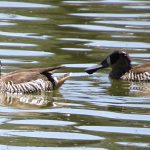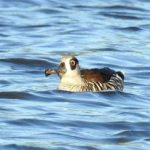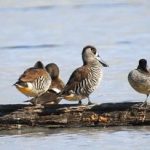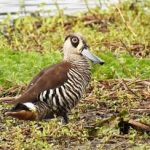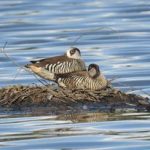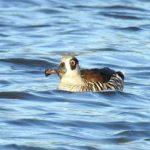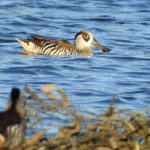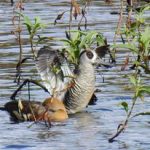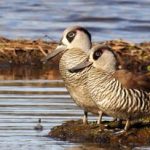PINK-EARED DUCK
Pink-eared Ducks are native to Australia and are primarily found in the southern and eastern parts of the continent. They inhabit a range of wetland habitats, including freshwater lakes, ponds, swamps, and temporary water bodies.
These ducks are characterized by their distinctive appearance. They have a large, broad bill with a dark pink patch near the tip of the bill, which gives them their name. Adult Pink-eared Ducks have a mainly grey-brown plumage with a pinkish wash on their underparts. They have mainly grey-brown plumage to their crown & upperparts while underparts are striped with black & white banding.They also have a white face with a ‘clown like’ dark eye patch.
Pink-eared Ducks are filter feeders, primarily consuming plankton and other microscopic organisms found in the water. Their unique bill structure allows them to filter small food particles from the water.
They often nest on the ground, using vegetation to create a shallow depression lined with down feathers. The female incubates the eggs, usually numbering around 5 to 12, for about a month. The ducklings are precocial, able to feed themselves shortly after hatching.
The Pink-eared Duck’s bill is specialized for filter feeding, making it one of the few duck species that predominantly feed on plankton and other small aquatic organisms. This adaptation sets them apart from the typical dabbling ducks that feed on plants and invertebrates.
Pink-eared Ducks are often seen in large flocks, especially during the non-breeding season. They are known to be social birds and may gather in large numbers on suitable water bodies.
While Pink-eared Ducks generally nest on the ground, they sometimes make use of old nests built by other waterbirds, such as grebes. This behavior is known as “nest parasitism.” Their population can be affected by changes in wetland habitats, water quality, and human disturbance.
Pink-eared Ducks go through a period of molting, during which they lose and regrow their flight feathers. During this time, they may congregate in larger groups in safe water bodies where they are less vulnerable to predators.
While Pink-eared Ducks are generally quiet, they can produce a variety of vocalizations, including soft whistles and grunts.
In addition to “Pink-eared Duck,” these birds are sometimes referred to as “Zebra Duck” due to the striking patterns on their plumage.
The Pink-eared Duck’s unique feeding behavior, distinctive appearance, and adaptations to its environment make it a captivating and important species in Australia’s wetland ecosystems.

